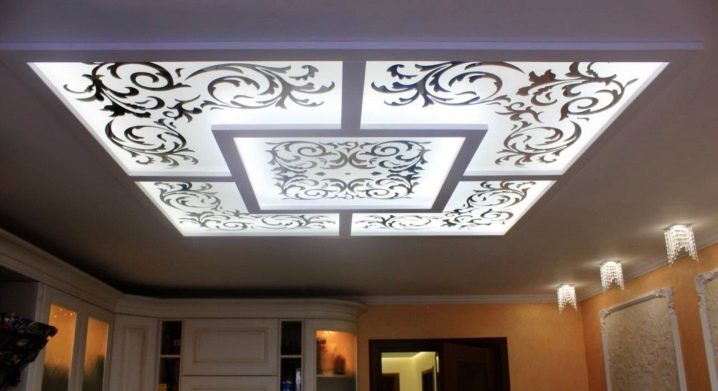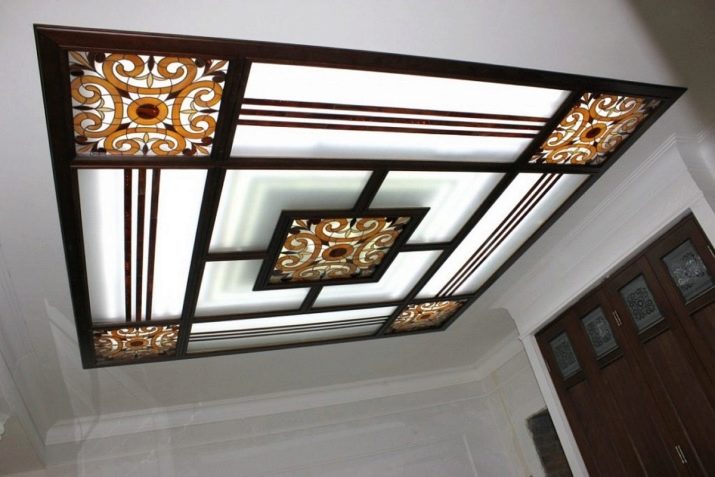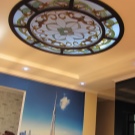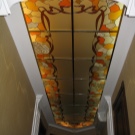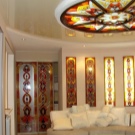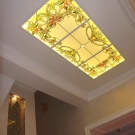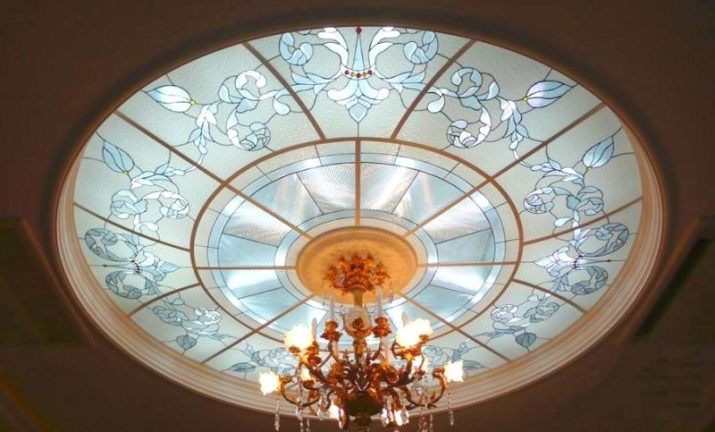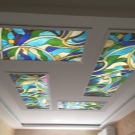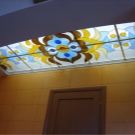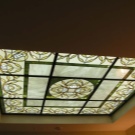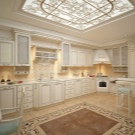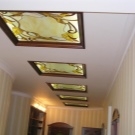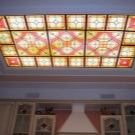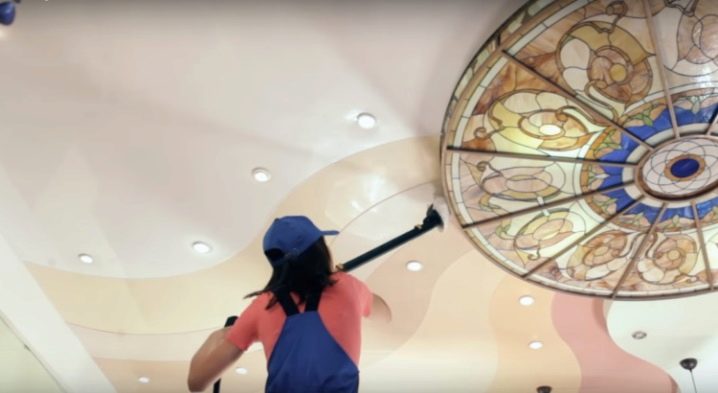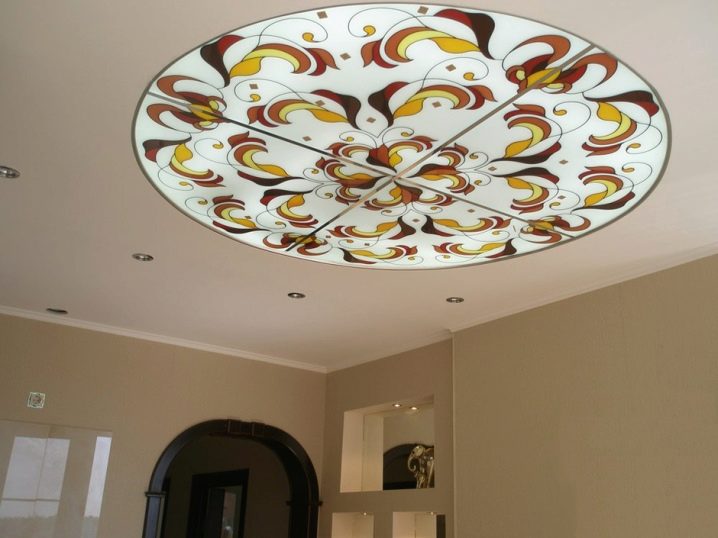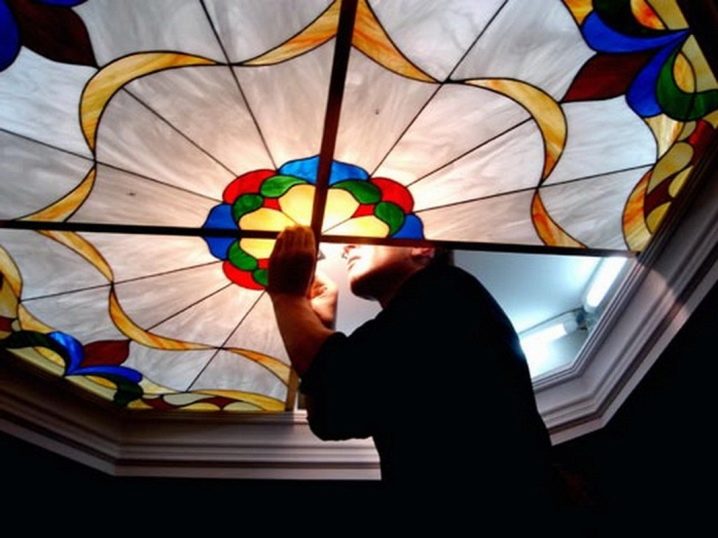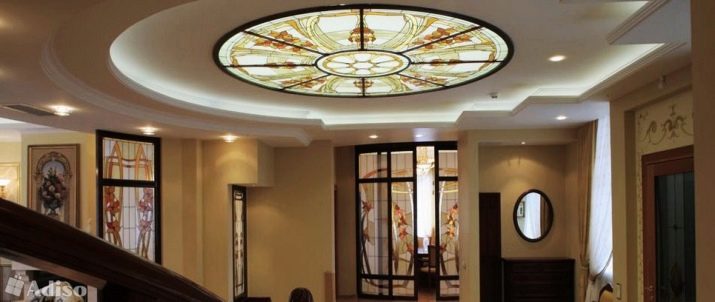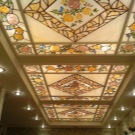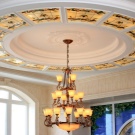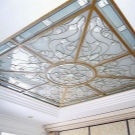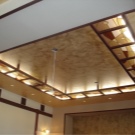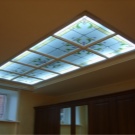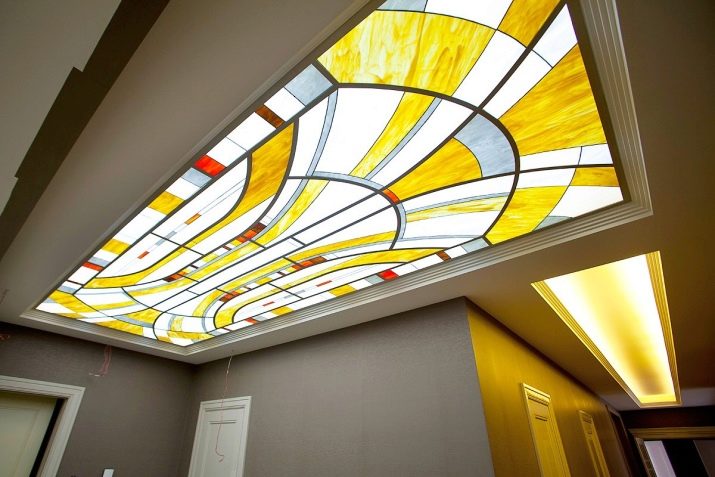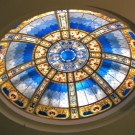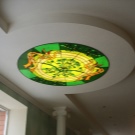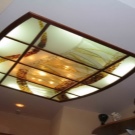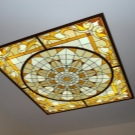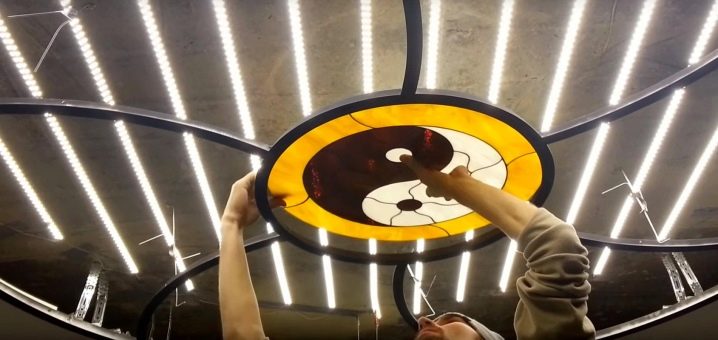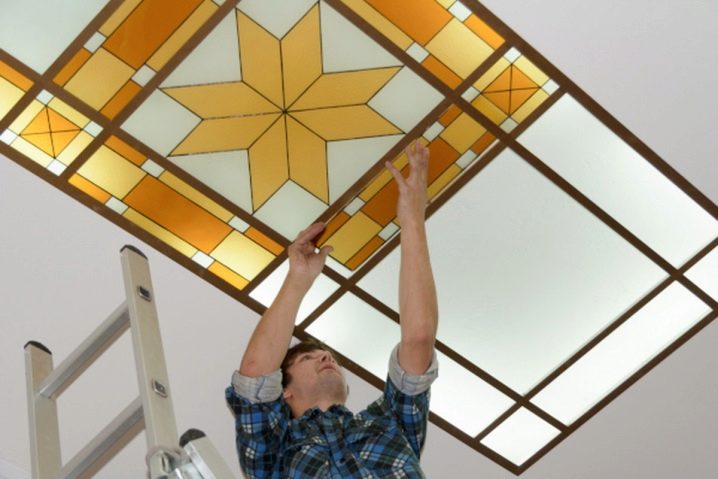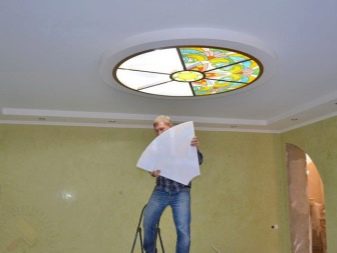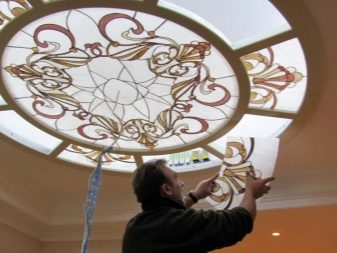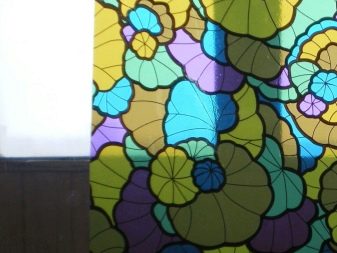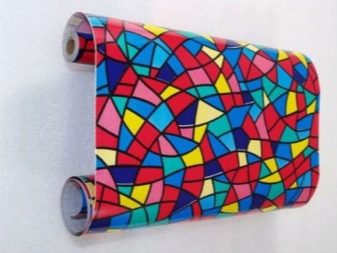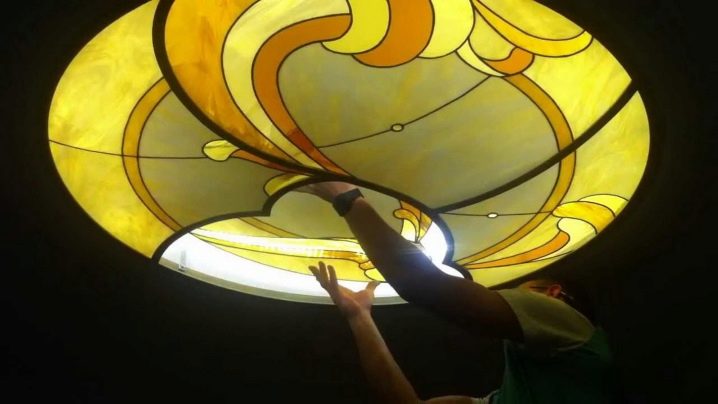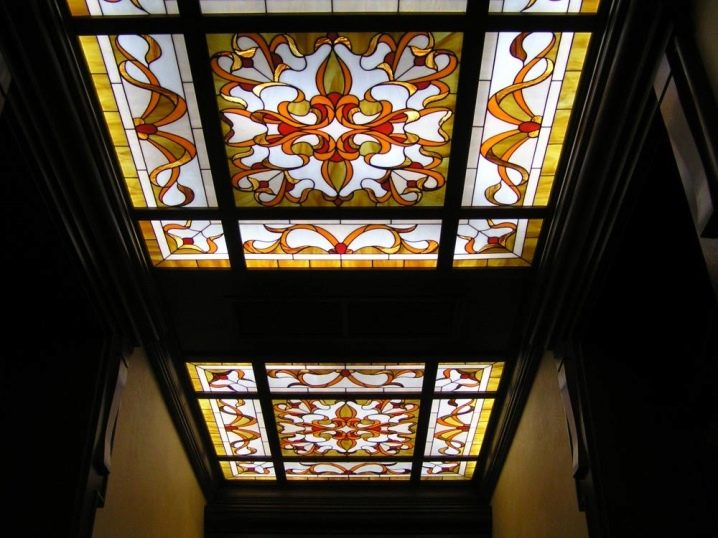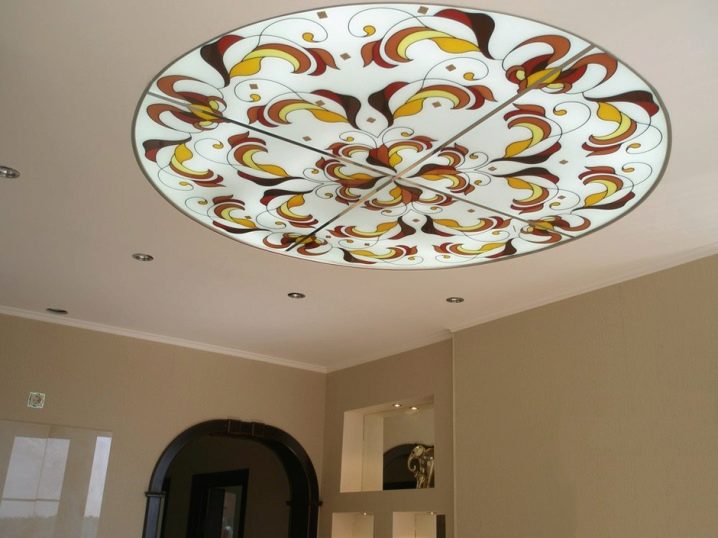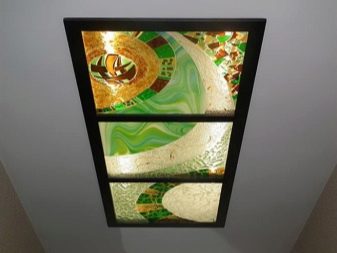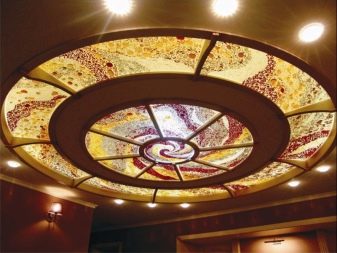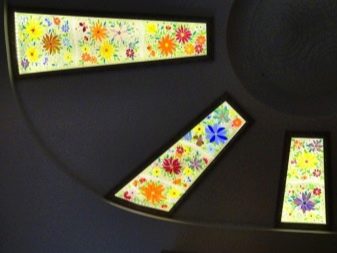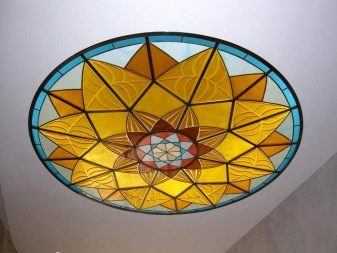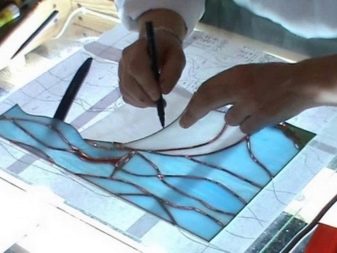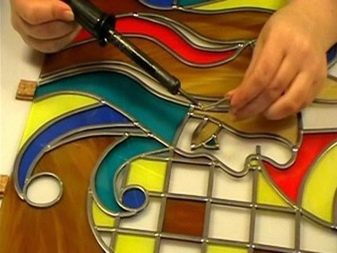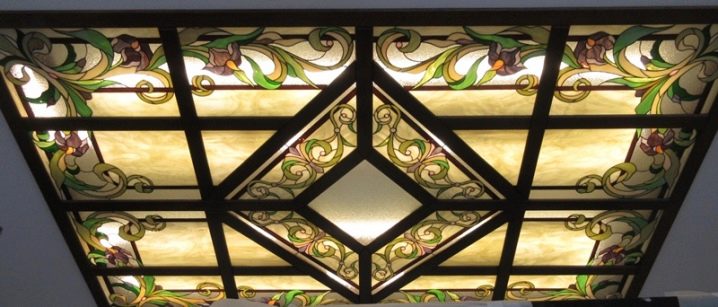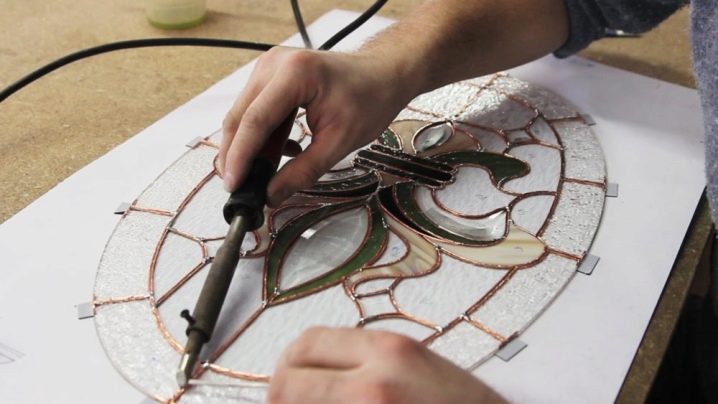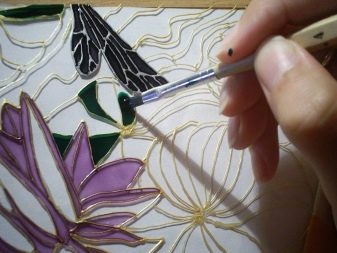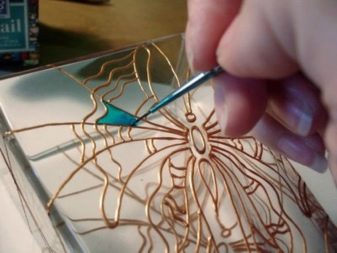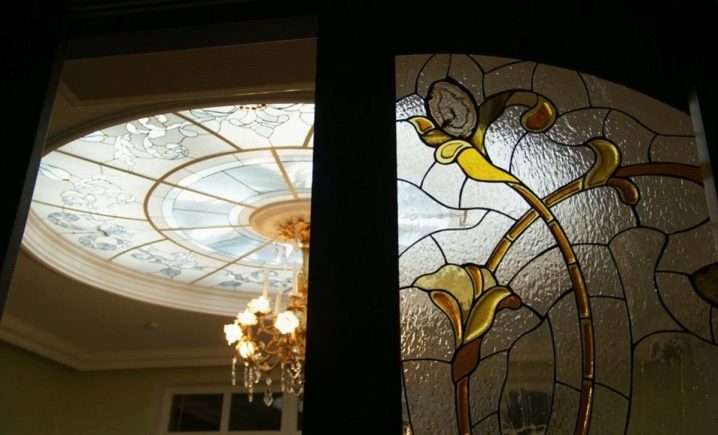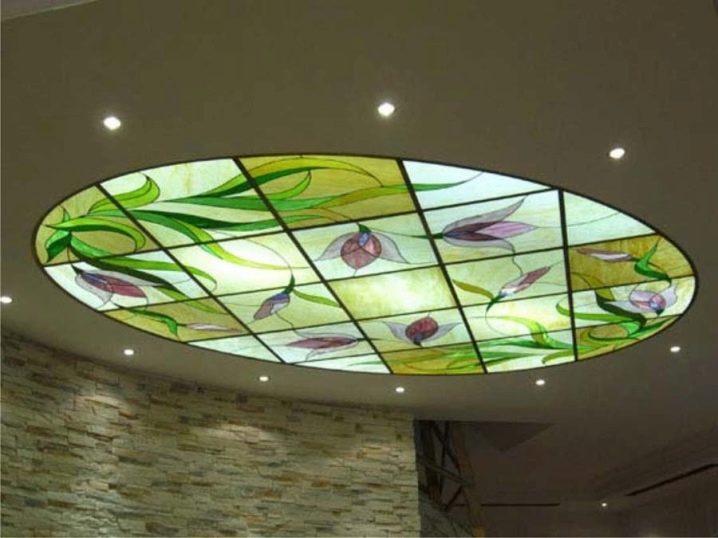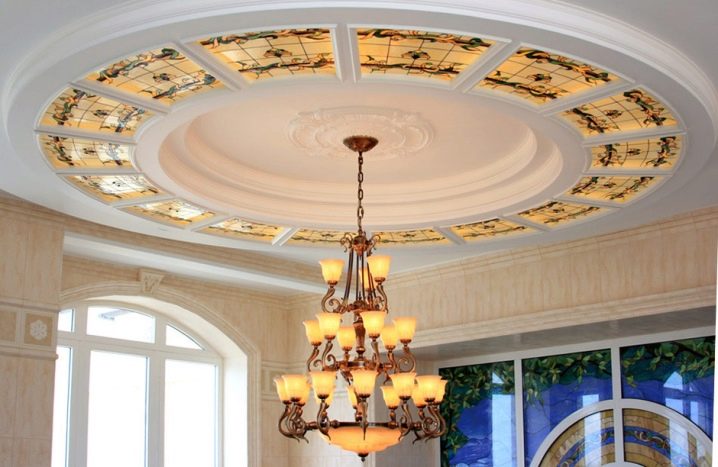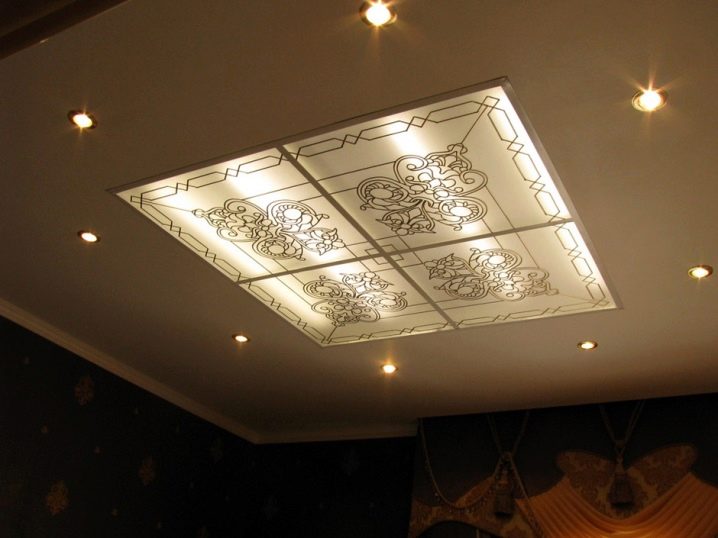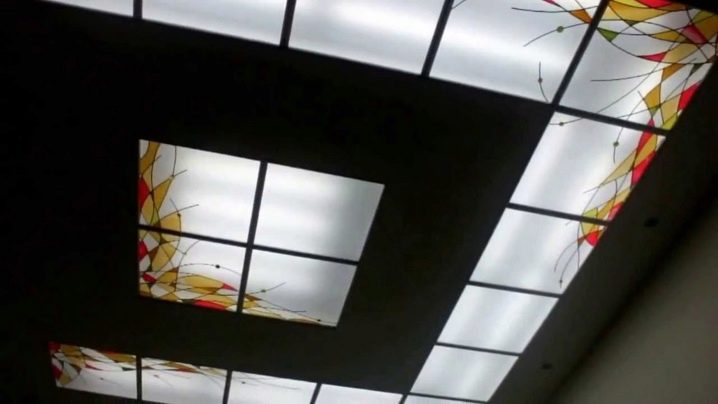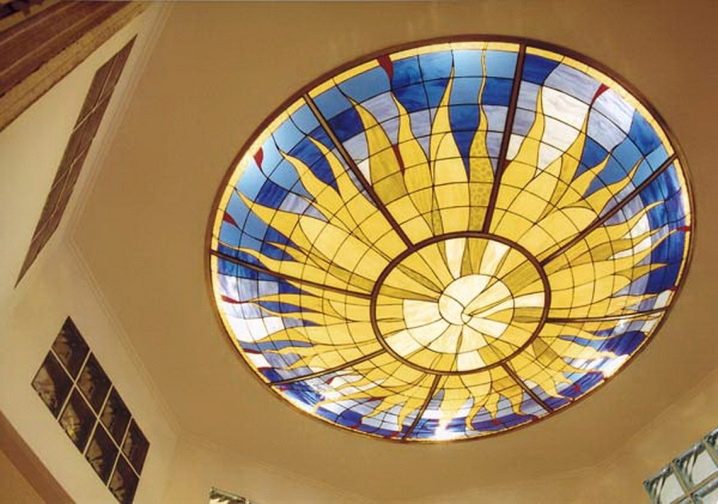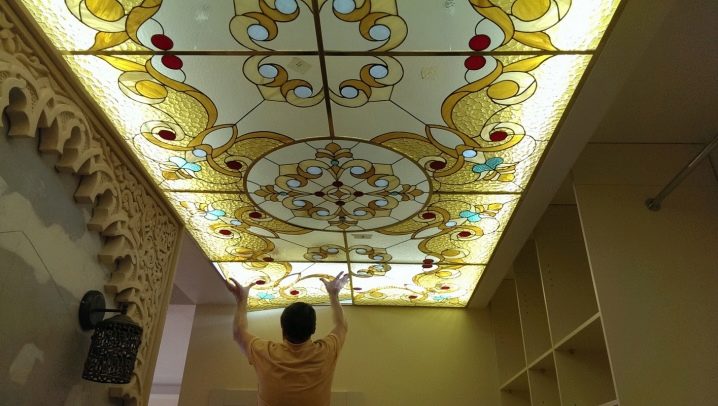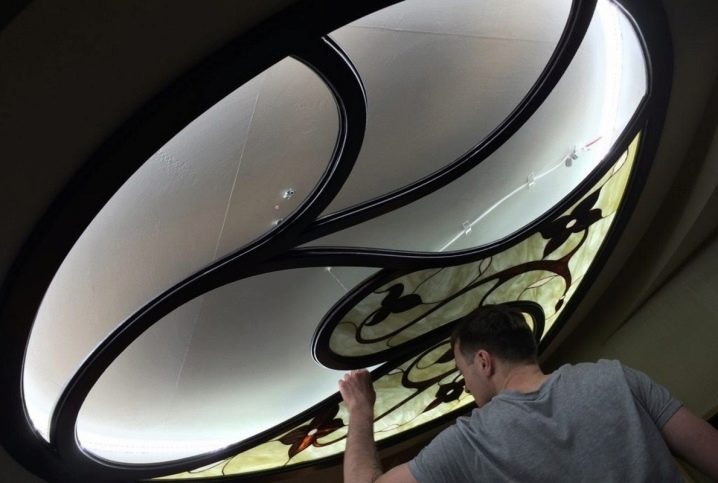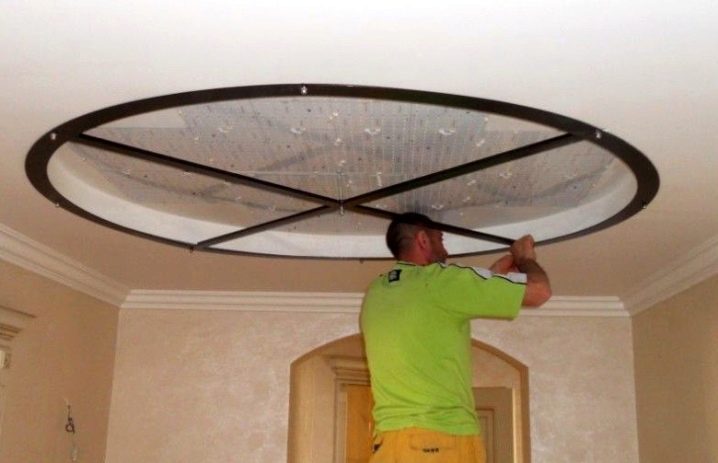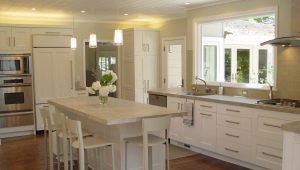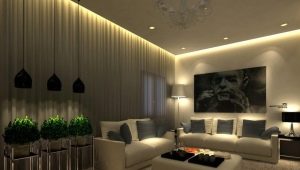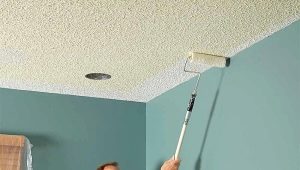Stained glass ceilings: features and benefits
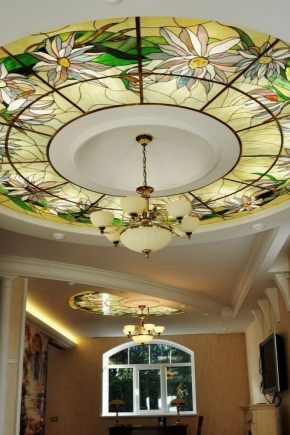
The stained glass ceiling began to be used as a decorative interior decoration at the beginning of the 20th century, and it almost instantly achieved enormous popularity. Already at that time for many people who wanted to get a ceiling with stained glass painting in their house was something unrealizable, because its cost was prohibitively high. Today, almost every homeowner can install a stained-glass ceiling and give their interior a bit of luxury and chic.
Special features
The basis of any stained-glass ceiling is a metal frame construction. The quality and strength of the frame directly affects the life of the stained glass ceiling.To date, stained glass on the ceiling in the apartment, at first glance, will seem something too exotic. But with a properly selected design and successful installation of such a ceiling will give the apartment a little charm and sophistication, because the stained glass ceiling is unique and elegant.
If the owner of the apartment has an oval corridor, then you can choose a stained glass ceiling in the style of a loft.
The advantages of the stained glass ceiling
In addition to the attractive aesthetic appearance, the stained glass ceiling has several other advantages:
- Diversity. Stained-glass windows on the ceiling are made in five available techniques, and the applied images can carry absolutely any character: from a picture and a plain arabesque to abstract color shades. Truly gifted artists create authentic works of art. Stained glass artists rarely do duplication, so we can safely assume that any design acquired is exclusive.
- Undemanding care. For glass, which is the basis for the stained glass ceiling, it is extremely easy to care for. It does not crack, like plaster, and does not sag like a stretch ceiling.To preserve the original appearance, the stained glass ceiling must be periodically cleaned of settled dust with a damp cloth.
- Durability. If you do not apply any mechanical effects on the stained glass ceiling, then it will serve the landlord for several decades. He perfectly copes with sharp temperature jumps, is not afraid of fungus and parasites and is completely immune to high humidity. Having installed a stained glass window on the ceiling in the bathroom, after many years it will look like new.
- Easy installation. With the plastered ceiling, the damaged or crumbling area must be plastered again, but at the same time it is necessary to work with the entire surface, otherwise the damage site will be noticeable.
But in the case of a stained-glass ceiling, everything is much simpler: if one of the glass elements suddenly breaks, then you need to remove it from the structure and replace it with a similar variant.
- Environmental Safety. Glass is an environmentally friendly material that is not capable of harming the human body. When used, it does not emit harmful, toxic substances.Glass is not subject to the growth of mold, has unique characteristics, and at the same time it is visually represented as a fragile and lightweight construction material. Nevertheless, glass is a very durable and chemical-resistant material, and, after the end of its operation, it is recyclable.
A lot of positive properties makes stained glass on the ceiling an extremely attractive and tempting option for finishing the ceiling surface.
Forms
Stained glass ceiling is made in the following forms:
- Dome - it will be extremely attractive to look in a spacious room. The apartment is the best option for the location of the stained glass ceiling is a living room. Often this type of form is used in public institutions, such as a shopping center, university, clinic or theater hall.
- Round - A good option for a private room. This ceiling fits well into the bedroom. Smooth forms will give the room an atmosphere of calm and tranquility.
- Ceiling lamp - the shape and size of this option vary, therefore, it is suitable for any type of room.The stylization of the pattern is chosen depending on the purpose that this type of ceiling should fulfill.
- Rectangular - the stained glass ceiling of this form is applicable in both residential and commercial premises. The only thing worth thinking about is the method of applying the image.
- Custom - the form of such a ceiling is limited by the preferences and tastes of the designer and artist. This option is appropriate in any type of room.
Distinctive features of installation
The process of installing a ceiling with stained glass is extremely difficult and requires certain skills and knowledge. It is performed by various technical characteristics methods:
- Suspended method. It assumes fixation of stained glass construction on metal frames, which are fixed to the ceiling with the help of specialized hangers. In most cases, stained glass is located on a small part of the entire space of the ceiling.
- Tension method. In this situation, the stained glass structure is located on a dedicated area on the surface of the tension fabric. The installation has similar steps to the previous method. The stained glass construction is carefully installed in the metal frame.Then the frame is fixed to the ceiling surface, throughout its area are specially designed for further mounting holes, with which the tension of the ceiling fabric.
- Cassette method. The basis of the installation work is the principle of working with a cassette ceiling. That is, the profile metal guides are fixed to the surface of the ceiling, in which square or rectangular plates are installed. In the case of installation of stained glass window cassette method must be fixed to the surface of the ceiling spring suspension. Then you need to build an aluminum construction of the panels, after which you can do the insertion of stained glass rectangular cells. There are two options for mounting: open and closed.
When looking at the ceiling with an open mount, you can see metal guides that create a visual grid. Closed mount masks these guides, so that visually this ceiling looks like a solid, even and smooth surface.
- Plafond method. In this method, the ceiling surface is left flat and flat.However, it makes a special niche or bulge to create the original picture. Such a ceiling amazes with the beauty of its relief.
Installing a stained glass version is not recommended in apartments with low ceiling height - it will create a feeling of pressure from above.
Production features
To date, manufacturers produce two types of finished stained glass ceilings:
Using film
The design with the film application of stained glass pattern in no case is not installed in the bathroom or rooms with high levels of humidity. The glass surface is covered with a special film on which the image is pre-applied. This option is unstable to moisture, and the film coating begins to peel off after a short period of time.
Using assembly
This type of stained glass is very expensive, but it is a really high-quality material. The process of its production is very laborious, because such a design is connected from a large number of pretreated glass elements.
Manufacturing differences
Below are a few basic techniques.
Tiffany
It is one of the oldest and most reliable methods of production, with the help of which the overwhelming majority of the centuries-old stained glass structures were built, which still decorate palaces and temples with their picturesqueness. Each section of the stained glass blends perfectly with the rest.
First, a drawing or a patterned ornament is applied, based on the outline of which it is planned to make a stained glass window. The work of the artist is divided into several parts. Then, using a grinder, the necessary elements are cut out of the glass surface. All parts are wrapped around the edges in metal foil. Using a soldering iron, the master solders the foil between the elements.
Fusing
This approach is used to obtain an abstract image and is the latest and futuristic method of making a stained glass image. With the help of her performed a complex multi-level stained glass painting.
The process begins with the preparation of a sketch by the artist, according to which the stained glass will be made later. Before sending a specialized glass cloth to the furnace, the artist depicts a carved sketch on it.In a furnace under the influence of a high burning temperature, the elements depicted melt into the glass structure, merging with each other. After that, a pattern is formed, very reminiscent of watercolor painting.
Classical
It is an old and usual method of stained glass processing. It does not have complex figurative elements - it uses a predominantly flat, rigorous pattern or geometric pattern.
First of all, the artist made a preliminary sketch. Then the craftsmen produce a frame construction of light aluminum materials according to the drawing, after which the necessary elements are machined using a grinding machine. The process ends with the insertion of metal elements into the frame structure.
Imitation
This method refers to a simple budget method. It is worth mentioning that the life of such a material is extremely small and has practically nothing to do with expensive expensive stained glass construction.
For the manufacture of required photo printing. The film with the applied image is glued to the glass tile. After some time, the film surface gets the ability to peel off.
A very common fill method. In this case, a contour is applied on a continuous glass sheet, which is subsequently filled with varnish. When painting the glass canvas is covered with specially designed for this paint.
Sand
This technique is quite time-consuming, since each tile is made separately. It is treated with dense streams of sand, which direct heated air. The resulting relief image is striking in its beauty.
Lighting and its meaning
In addition to the methods of production and installation, not the last role is played by lighting devices, with the help of which the ceiling surface is illuminated.
From the place of their installation will depend on what the atmosphere will acquire the living room.
- In the center. To do this, use one massive lighting fixture, for example, a chandelier located in the center of the stained glass structure. If necessary, you can focus on a specific part of the stained-glass ceiling, while the middle of the structure will be highlighted, while the remaining elements will disappear a little in the twilight.
- Along the borders. An interesting idea in which lighting devices are located on the borders of the stained glass design.In this regard, unlike the previous version, the central part will be darkened and gloomy, while the edges of the stained glass painting will attract the maximum attention of those present.
- Over the entire surface of the ceiling. This approach is an excellent option for illuminated stained glass ceilings, in the manufacture of which was used frosted glass. This type of material will allow you to dim the illumination of lighting and give the living space a uniform and pleasant light. Also, this option will be a good choice for stained glass designs with simple geometric patterns and an abstract pattern that does not require special lighting to highlight any details.
Many stained glass ceilings carry a certain pattern, atmosphere or character. In this case, it will be correct to emphasize and fill in the precise meaning the details that require it. For example, with a stained glass ceiling depicting the sun, it would be appropriate to arrange the light sources in such a way that the light emanating from the lamps resembles the rays of the sun.
Mounting method
Often in living rooms using rectangular stained glass.For such a ceiling format, you will need to install a solid metal frame structure throughout the area of the room. On the ceiling surface parallel to the axes of the installed frame, points should be marked for future hangers with an interval of 60 cm. Then, holes are drilled at the marked points and anchors made of steel 20 cm long are fixed for future installation of the suspension. In general, about 8-10 bolts are used for fastening.
It is recommended to take into account the weight of the stained glass structure. Then make the fastening of the main profiles in the guides and to the suspension. After some time, it is necessary to fix the auxiliary profile to the main profile in the place where in the future it is supposed to join glass layers. The result should be a grid of metal, which is a single-level frame construction.
The fixing of the frames is required solely by level, which eliminates the risk of glass falling out of the metal frame. To do this, use a cord or fishing line.
Since the frame structure is used for the installation of the ceiling with stained glass, accordingly, there is no need to perform any kind of preparatory or hospitality work with the ceiling surface.
The markup for communication and air-conditioned systems will eliminate the possibility of overheating and short-circuiting. After completion of the preparatory work is required to proceed to the sources of lighting. It is recommended to invite a specialist who correctly performs the actions for working with electrical wiring. It is worth starting to mount the stained glass only after all the installation work has been completed on the lighting devices.
Glass stained glass plate is fixed in the cell frame structure with screws. It is worth mentioning that some glass plates must be left without fastening - this will allow you to quickly and comfortably gain access to the lighting source in case of maintenance or replacement.
See how to install ceiling stained glass windows in the next video.
